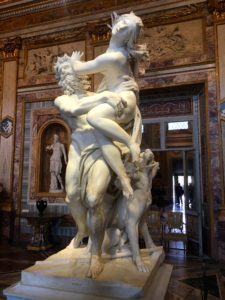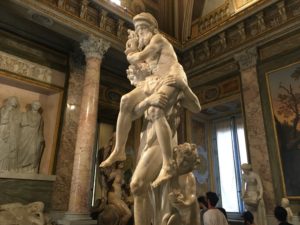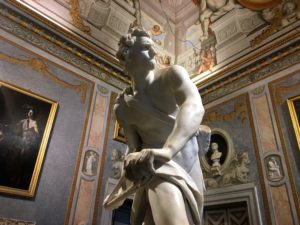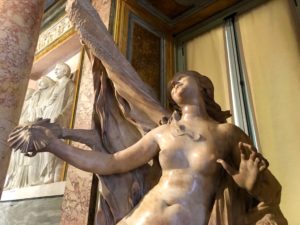BORGHESE GALLERY / Selection from Bernini’s works
Galleria Borghese is an art galley in Rome housed in the former villa Borghese Pinciana. The Galleria Borghese houses a substantial part of the Borghese collection of paintings sculpture and antiquities which was collected by Cardinal Scipione Borghese (1577-1633) the nephew of Pope Paul V. (1605-1621) Scipione Borghese was the patron of the painter Caravaggio (1571-1610) and the artist Gian Lorenzo Bernini (1598-1680) Between 1618 and 1623, Bernini worked primarily for Scipione Borghese.

The villa Borghese was built by the architect Flaminio Ponzio (1560-1613)
The Galleria Borghese includes twenty rooms across two floors.
Many of the sculptures are displayed in the spaces for which they were intended, including many works by Bernini.
Here are my choices from Bernini’s works !!!

The Rape of Proserpina is one of these amazing works. A must to see….

Proserpina (Greek Persphone) was the queen of the underworld in the Greek Mythology. She was the daughter of Zeus and Demeter. She was married to Hades, the god of underworld.
On this work we can see a dynamism immediately taken up by the marble that is alive and throbs through the contrast between Prosperina’s defenseless soft body and Pluto’s powerful anatomy.
Properina’s youthful flesh that reveals all its soft sensuality as she struggles in vain to break free of Pluto’s rough arms. As she twists, she fills the lustful hands of the god of the underworld with the soft folds of flesh that are the joy of lovers.

Bernini’s own son and biographer, Domenico stated that this sculpture is an amazing contrast of tenderness and cruelty.
Aeneas, Anchises, and Ascanius was the first work Bernini made for Cardinal Borghese. In contrast to Raphael’s famous fresco of this motif in the Stanza of the Vatican Palace, Bernini’s sculpture remains extraordinarily close to Virgil’s text, apparent in the Phyrigian headgear of Anchises, a reference to his eastern origins, as well as the fact that he is being carried on Aeneas shoulders. (Anchises had been made lame by an avenging bolt of lightning from Jupiter) Aeneas exemplary conduct may be an allusion to the name of the work’s patron, Scipione.


*Aeneas is a Trojan who left his home city and eventually ended up in Italy, where he became a progenitor of the Roman people.

The precise scene depicted is the moment when Aeneas carries his father, the elderly Anchises, and his son Ascancius from Troy, after it has been sacked by the Greek army. In his hand, Anchises carries a vessel with his ancestors’ ashes, on the top of which are two tiny statues of Di Penates, Roman household gods.
Apollo and Daphne
Without a doubt the work which, due to its unparalleled virtuosity, most astonished Bernini’s contemporaries was the Apollo and Daphne. This sculpture was the last of a number of artworks commissioned by Scipione Borghese early on in Bernini’s career. Much of the early work was done in 1622–1623, but a pause, quite possibly to work on the sculpture of David, interrupted its completion, and Bernini did not finish the work until 1625.

This sculpture shows the frustrated love of the god Apollo for a nymph who preferred to turn into laurel tree rather than give into his passion. Here, the classical model for the young Apollo can be seen.
Bernini did not finish the sculpture by himself; he had significant help from a member of his workshop, Giuliano Finelli, who undertook the sculpture of the details that show Daphne’s conversion from human to tree, such as the bark and branches, as well as her windswept hair.


While the sculpture may be appreciated from multiple angles, Bernini planned for it to be viewed side on, allowing the observer to see the reactions of Apollo and Daphne simultaneously, thus understanding the narrative of the story in a single instant, without the need to move position.
David
In 1623, only 24 years old Bernini was working on the sculpture of Apollo and Daphne. For unknown reasons, he abandoned this project to start work on the David.

In contrast to the famous work of his predecessors Donatello and Michelangelo, Bernini chose to depict the moment of battle with the giant Goliath. The motif of the body’s torsion may have been taken from the antique statue of the so-called Borghese Gladiator which is now in the Louvre.


The subject of the work is the biblical David about to throw the stone that will bring down Goliath which will allow David to behead him. The sculpture broke new ground in its implied movement and its psychological intensity.
Truth Unveiled by Time “La Verita” is another great marble sculpture by Bernini.


Made between 1646 and 1652, Bernini intended to show Truth as a naked young woman being unveiled by a figure of Time above her, but the figure of Time was never executed. Bernini still expressed a wish to add the figure as late as 1665.
Important Notice: These are just few works of Bernini. If you want to discover more, just contact me: cenk@tutkutours.com

